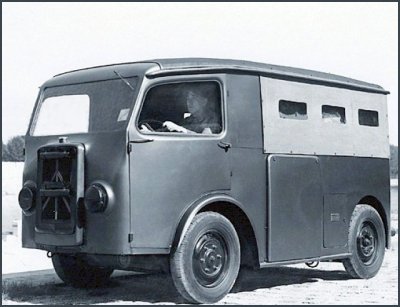
 |
| In the summer of 1936, Pierre-Jules Boulanger turns his attention to a
dossier bulging with photos, sketches, statistics, and descriptions
of the ways in which the new utility van would serve its owners in
making door-to-door deliveries.
The results of the study show that the prospective users need a vehicle with a forward cabin in which they can remain standing, and which also gives them access to the rear from the driver's position. In addition, the vehicle should have a lateral door on the side next to the sidewalk (pavement) to make it easier to load and unload cargo. In the autumn of 1937, the design office completes the first rolling prototype of a new vehicle that bears no resemblance to any previous design. On 12 May 1939 the government examines and approves a utility van named 7-T series U carrying chassis number 900000 and fitted with motor number TB 00032. The TUB is born, and it's a true innovation! Its name comes as an abbreviation of Traction Utilitaire de type B (Traction Utility Van Type B). It borrows the 35 hp, 4-cylinder motor of the 7C (9CV) and places it in the extreme front of the vehicle. The chassis is comprised of two cross-braced longerons. The floor up in front is high enough to house the mechanical bits and still allow for a cabin above. The cargo floor in the rear is set as low as possible (42 cm / 16" above the ground) to permit a man to stand (interior height 1,75 m / 5'-9"). The side door is a sliding type rather than swinging -- a completely new feature in this genre of light utility vehicle. The bodywork is very simple, having been assigned to the carriagemaker Fernand Genève for execution. The rear portions of the sides are covered with curtains made of tarpaulin fabric cover and containing window openings made of flexible transparent material; the right one is permanent, but the left one can roll up to the level of the rain gutter. Once the overhanging hatch/roof at the back has been opened, and the rear panel removed, one has access to more than 6 cubic meters of storage space. The spare tire and battery are stored in external compartments on the left side, making them easily accessible while avoiding all contact with the merchandise in the cargo area. The mechanical components come from the 7 CV, including gearbox and front drivetrain with torsion-bar suspension. The rear is a conventional setup with semi-elliptical springs. Brake parts also come from the Traction; the system is fully hydraulic and uses the 6-lug drums of the 11 CV. The TUB is announced for sale on 5 June 1939 with a price of 36000 francs. The following year, on 13 February 1940, the government approves the 11-T Series U, the first vehicle carrying serial number 950 001. While the 7 CV and 11 CV TUBs have the same load rating of 1020 Kg (2244 lbs),one can tell them apart since the 7 CV has only a single windscreen-wiper on the driver's side, there is a sheetmetal ridge serving as a sort of symbolic bumper along the base of the body, there are two fuel-fillers, and the battery access panel is smooth (the 11CV panel has 4 vents in it). The Type 11-T Series U-C or TUC (Traction Utilitaire de Type C) appears during the war, on 23 June 1941. A few minor modifications to the the stock TUB, the most siginificant being for the user, with cargo capacity rising from 1020 Kg to 1200 Kg. An ambulance version existed also: the TAMH. Very few of these curious vehicles were sold, the war limiting its distribution to less than 2000 units. The 1946 Salon de l'automobile was the first and last for this vehicle; by the following year its successor the Type H was ready, precluding any hope of continued production. Some statistics:
 Le type
H Citroën Le type
H Citroën |